
Day Two
Rawlinna
I awaken at 6:00 am to pink, orange, and red light filtering through the curtains into my cabin. A magnificent sunrise is developing across an unending landscape. Sleepily pulling on a sweatshirt over my pj’s I make my way down the corridor to the coffee bar. I find a hot water faucet, a selection of teas, sugars and powdered cream . . . and packets of powdered coffee. I’m a coffee snob, I’m afraid. Back home, I grind my own beans each morning before pouring boiling water over them through a cone filter. I’m not unfamiliar with instant coffee, but don’t drink it if there are any other choices, and I had already sampled the coffee brewed by our chefs — it was excellent. I would wait. I return to my cabin and snoozed as I watched the colors fill the sky, then fade away, replaced by a low haze. The outback stretches in all directions with no man-made artifacts beyond the train tracks. I awakened the second time to the sound of screeching brakes and the familiar squeaks and creaks the train elicited whenever it slowed down or stopped. This was apparently Rawlinna, where we were to have our breakfast. I stared out of my window. Really?
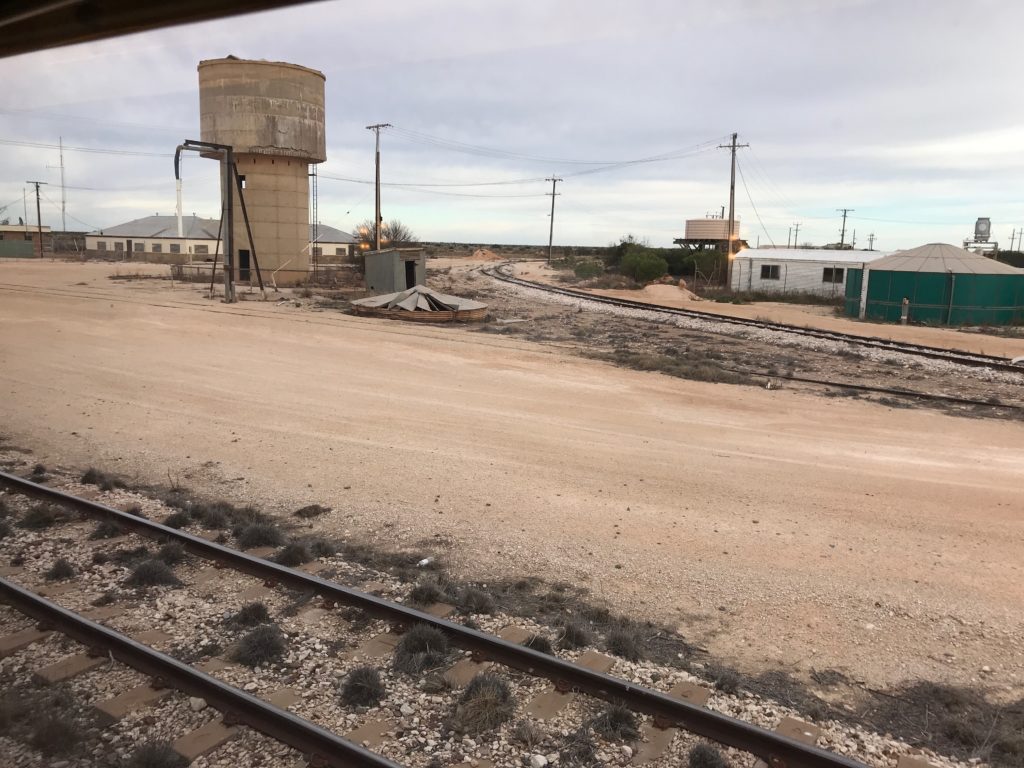
Suddenly I hear one of my carriage mates calling me. Everyone else has walked down to the parlour car and is leaving the train. We rush down the narrow corridors and detrain with the others. Now we mill about, passengers in gold class and platinum together, all in search of orange juice, tea and coffee. Our hosts do not disappoint. Braziers have been lit by staff from a nearby sheep station, and as we warm our hands around them, large containers of the desired morning beverages are carried from the train to long trestle tables. Soon those will be made up with cutlery and dishes.
Beverages in hand, conversations turn to sleep. “How did you?” “I didn’t.” Trains are noisy, and bumpy, and not everyone is able to think in terms of rocking cradles when they are tucked into their beds. I love trains, but I traveled on them very early in childhood, and for me they are like comfort food for my body. I had fallen asleep whispering “I think I can I think I can I think I can,” and hadn’t awakened until sunrise. Others were not so fortunate. Then we moved on to other more arcane topics, such as complimenting the three meals we had already eaten, and wondering what our chefs were cooking for our breakfast. We didn’t have long to wonder. In short order the tables were made up with cutlery and dishes, and hot food quickly followed. Our resident musician is there with his guitar and his American folk songs, and as we warm up and enjoy the meal, once again it feels like a party. As our amazing wait staff keep our plates and cups full, they fill us in on Rawlinna. At 2.5 million acres, Rawlinna Station is Australia’s largest sheep station. Established in 1962, the station stocks more than 70,000 sheep and regularly sends wool to Adelaide for sale. As we eat and talk, the sun breaks through the haze and we are soon warmed through with its heat. Too soon, we are herded back to the parlour car and our cabins, which have been miraculously transformed from bedrooms back to cozy lounges.
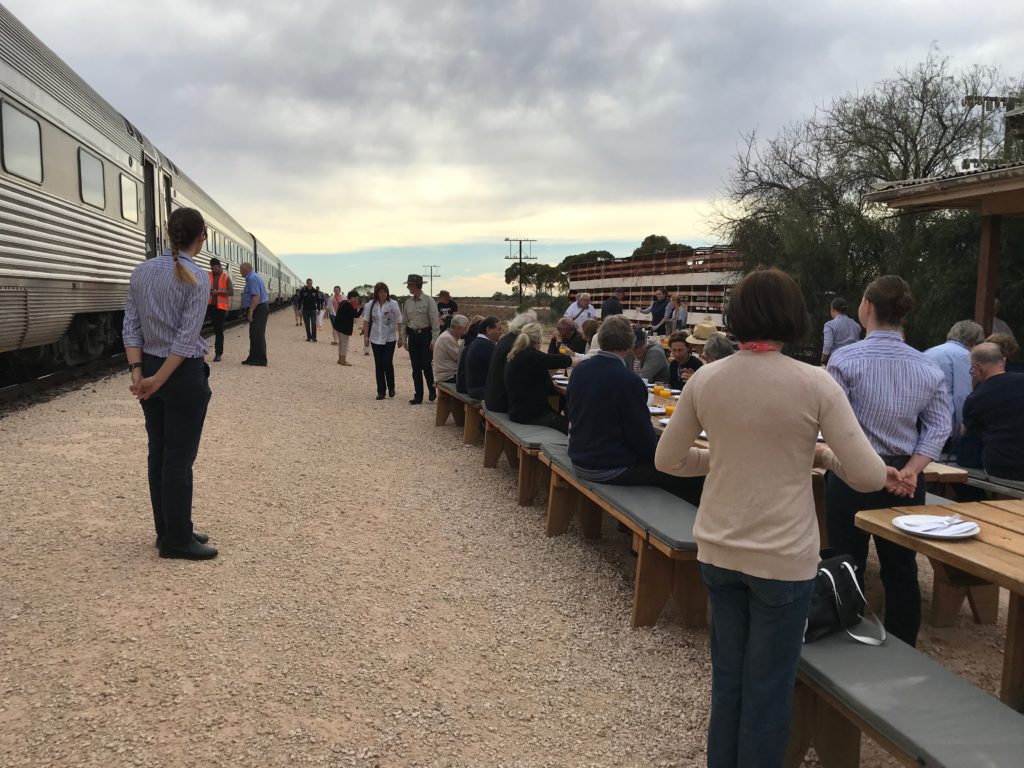
It is about 300 miles from Rawlinna to Cook, our next stop, and I spend most of the day in the parlour car. Wine, beer and spirits were served all day long, and my companions were already quite cheerful. The bartender told me that the wine I was drinking came from the Hunter Valley in New South Wales. Most of the food and drink, he said, came from the finest produce and grape growing regions in Australia. In fact, the Indian Pacific Railway was named by Gourmet Traveler Magazine as one of the “top 100 Australian culinary experiences,” by Conde Nast Traveler as among “the world’s best train food,” and by Britain’s Daily Telegraph as “one of the world’s tastiest rail journeys.”
Along with the staffed bar and the collected accolades, this traveling happy place was also well-stocked with books and games, so I selected a deck of cards. While I play Go Fish with an 80 year old English gentleman fulfilling his bucket list, I listen in on several conversations. My fellow travelers are from all over the world, but some are Australian. Some appear to be quite wealthy, but not everyone is on vacation. One youngish (meaning not grey-haired) man was leaving his home in Perth, where he had worked for 20 years, to return to Tasmania, where he grew up. His car and many of his possessions were on the train with us; by taking the train he was avoiding driving the 2700 miles from Perth to Sydney or paying to transport his car. One couple, traveling from Perth to Adelaide to visit their daughter, explained that they avoided plane travel since it had become so stressful, and they hadn’t wanted to cross the Nullarbor Plain by car.
We cross the border into South Australia just before lunch, and enter the Nullarbor at the same time. Our route exaggerates the remoteness of the plain in the 21st century; there is actually a highway (the Eyre) that traverses this area, and it is traveled by thousands of adventurers each year. The Nullarbor stretches along the southern edge of Australia between the goldfields of Western Australia and the Eyre Peninsula in South Australia. You can start the journey from Adelaide or Perth and drive west to east or east to west along the Eyre Highway. The full journey is often called “The Great Australian Road Trip.” Just the same, as with Death Valley in my home state of California, some serious planning should take place before attempting to enter the Plain by car or jeep. The spinifex is about the only vegetation that survives on the Nullarbor, and there are no fast food stores, gas stations, or camp sites for many miles. No internet either.
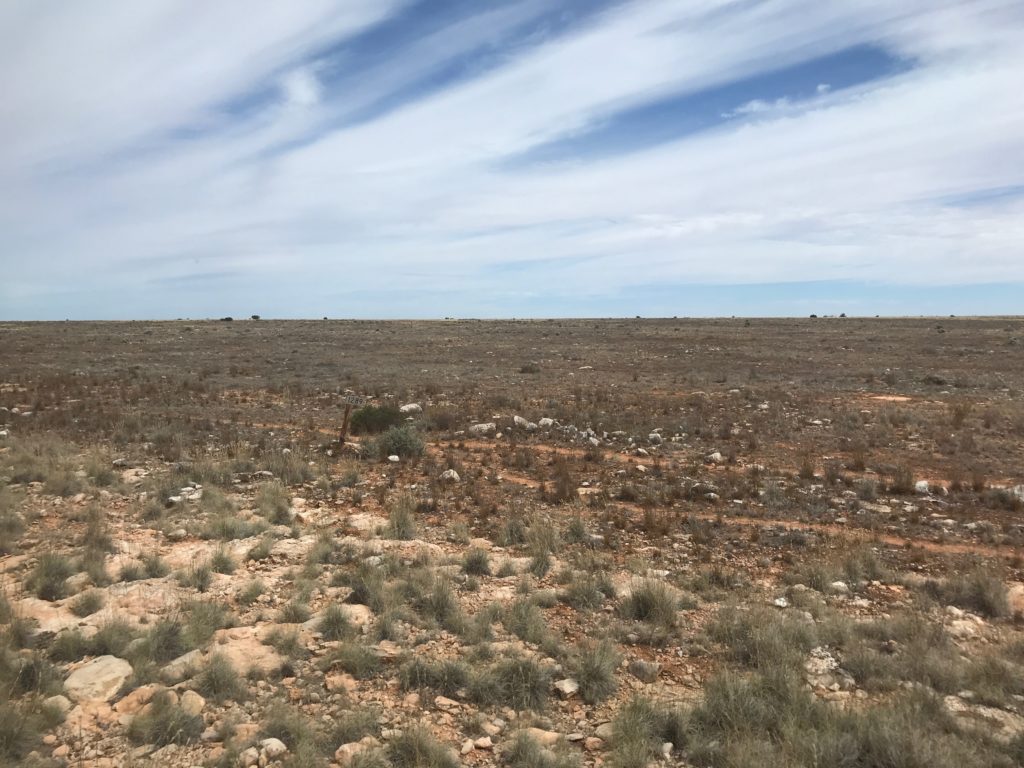
Cook
Cook is a ghost town. Established to support the east-west Trans Australian Railway, which was completed in 1917, Cook was one of many settlements built about 20 miles apart along the most remote sections of the track. It eventually grew into a base for maintenance teams and a place to stay for railway crews. At its peak, Cook was a thriving community of over 200 with a school, swimming pool, general store and housing. 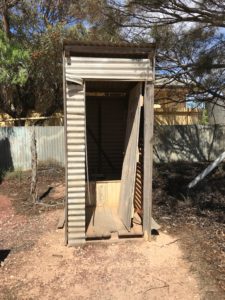 It now has a population of 4, all employed by the Indian Pacific Railway. The town died in 1997 when the railways were privatized and the new owners saw no need for a support town.
It now has a population of 4, all employed by the Indian Pacific Railway. The town died in 1997 when the railways were privatized and the new owners saw no need for a support town.
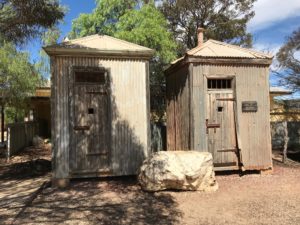
These are the “historic jail cells” of Cook
The diesel refueling facilities are used by the Indian Pacific, however, and engineers change shifts here and use the overnight accommodation. The bush hospital is closed, but the town maintains some medical supplies in the event of a train disaster. As we disembarked in Cook, our Hospitality Attendant instructed us to move our watches two hours forward. Australia has strange time zones, I learned. Some of them are half-hour and quarter-hour zones. Not all states and territories use daylight savings time, and some portions of a state are in different zones than others.
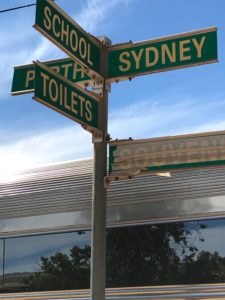
We were given an hour and a half to explore Cook, which was more than enough. It was quite hot by now, but the air was dry and it felt good to walk around. Passengers went in different directions, some alone, some in small groups. The four of us who ate together started out walking together also, but we discovered we had different walking paces and different interests, so eventually we split up.
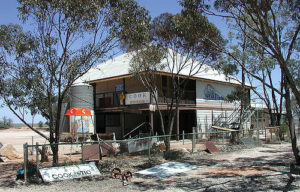
Cook School courtesy of InTheBush*
Day Three
Our Last Meal Together
The next morning, we were scheduled to arrive in Adelaide at 7:40 a.m. so appointed meal times were suspended. The four of us trekked down to to the dining room at a little before 7:00 to find our fellow passengers exchanging hugs, names and addresses. It felt a little like the end of summer camp. That’s when the train stopped. And stayed stopped.
We were on the outskirts of Adelaide by then, but apparently the track we needed to use was unavailable. Another train was late; we were shuttled off to a siding to wait. This was the view from my cabin:
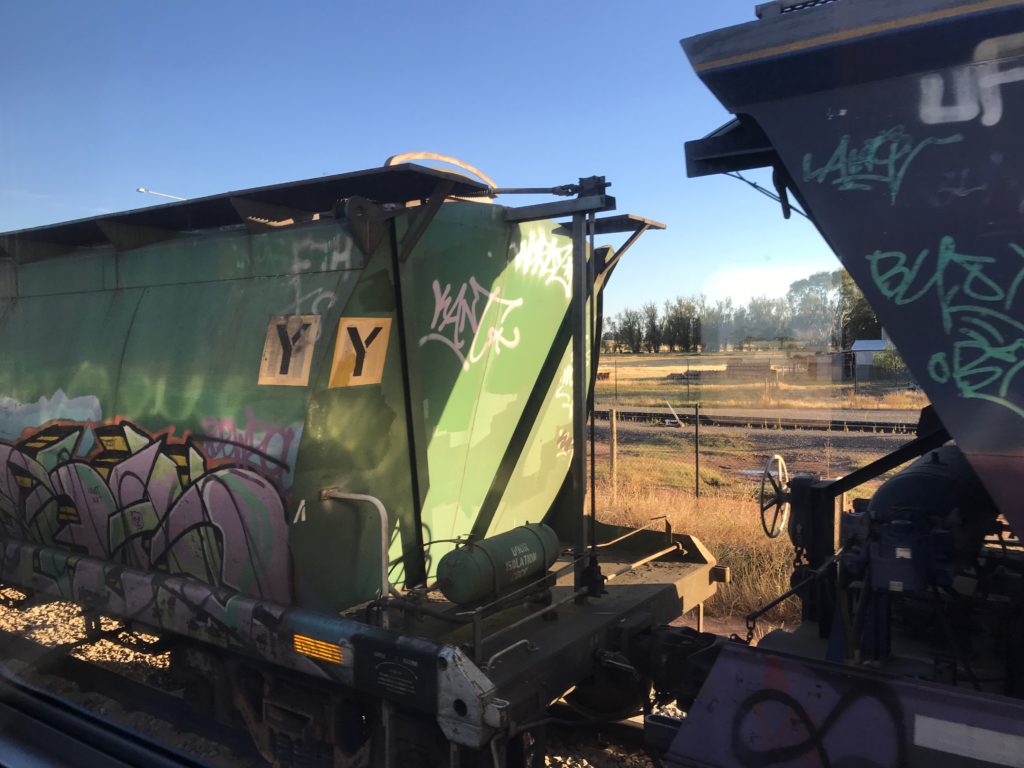
Adelaide
Our arrival in Adelaide was anticlimatic. Mostly, passengers left the train as they had arrived, alone or in couples, struggling with luggage. The community we had felt for the last three days no longer existed, and we went our separate ways. I had signed up for a guided walking tour of Adelaide, so I left my knapsack in my cabin as instructed, hoped that it wouldn’t travel on to Sydney without me, and headed for the tour buses. Since the train was nearly two hours late arriving, we walked very fast to complete the route set out by the guide. The bus dropped us near the New Royal Adelaide Hospital and we sprinted east along the North TCE (Terrace) stopping briefly to admire the National War Memorial.
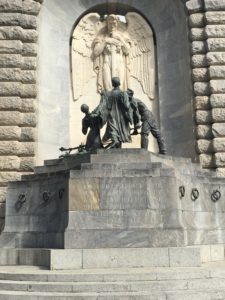
National War Memorial
On the front was inscribed “To perpetuate the courage, loyalty, and sacrifice of those who served in the Great War 1914-1918.” The Spirit of Duty holds an unsheathed sword upright as a cross, calling young men and women to war and sacrifice. The bronze figures of a farmer, scholar and young woman cast aside the symbols of their civilian lives as they respond to duty. In the crypt beneath the statue is a brass plaque listing fallen Australian soldiers.
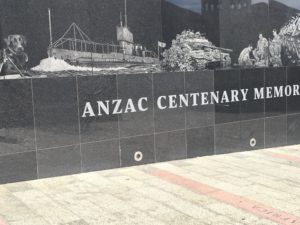
Anzac Centenary Monument
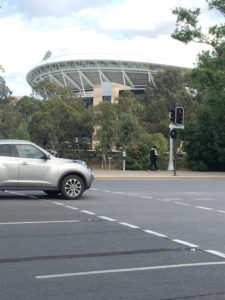
The New Cricket Oval
Turning on to Kintre Avenue, we walked along the new ANZAC Centenary Memorial Walk to Government House. As we rushed past, I learned that the Governor is Vietnamese and very well loved. 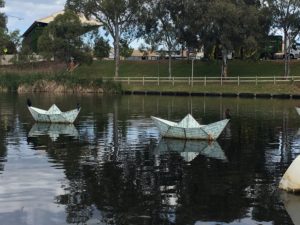 Next we crossed the River Torrens and passed the Adelaide Cricket Oval (The Ashes were playing that afternoon) and the Women Pioneers memorial, which was my favorite. We ended our tour at a Bistro near the Oval: Mimosas and and fresh fruit, tomato cheese croissants, bacon tomato croissants and a restroom.When we finished we were loaded back on to the tour bus, which returned us to the train just in time for its departure for parts east, and eventually on to Sydney.
Next we crossed the River Torrens and passed the Adelaide Cricket Oval (The Ashes were playing that afternoon) and the Women Pioneers memorial, which was my favorite. We ended our tour at a Bistro near the Oval: Mimosas and and fresh fruit, tomato cheese croissants, bacon tomato croissants and a restroom.When we finished we were loaded back on to the tour bus, which returned us to the train just in time for its departure for parts east, and eventually on to Sydney.
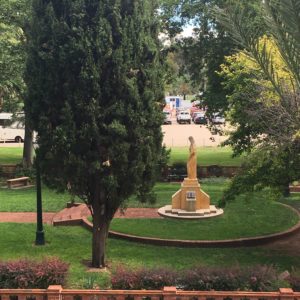
Pioneer Women Monument
My knapsack was waiting for me at the train depot, along with my roller bag, and the attendant kindly called a taxi to take me to my hostel.
For the first time since arriving in Australia, I was alone.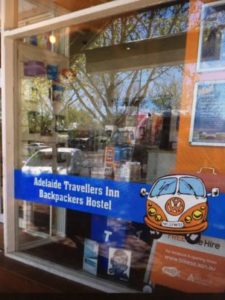
* * * * * *
Episode 5 will chronicle my journey from Adelaide to Melbourne on an eco-tour bus with ten young travelers and a quixotic driver/guide. Check back next week for that. The final episode in this six part series will share glimpses of my visits to friends and family in Victoria, New South Wales, and Queensland. To get these posts in your email when they are published, subscribe by entering your email address in the form at the right. See you next week!
Share this post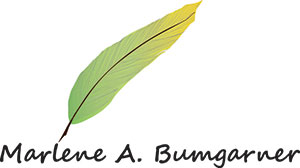
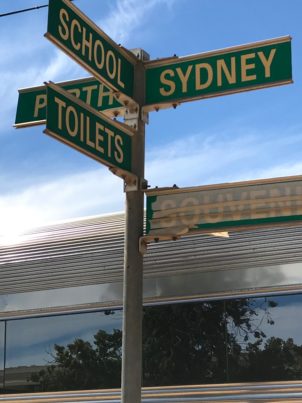
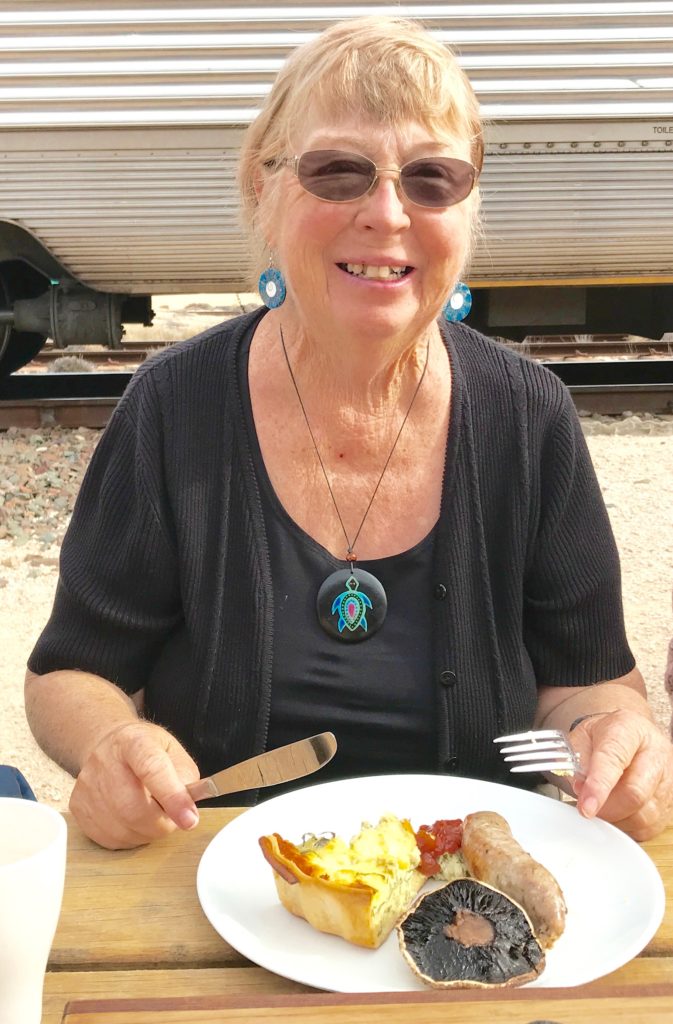
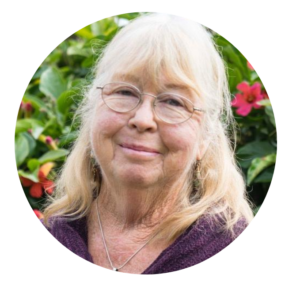


I am so glad you have a newsletter to insipire me to do more , be more as a single woman.